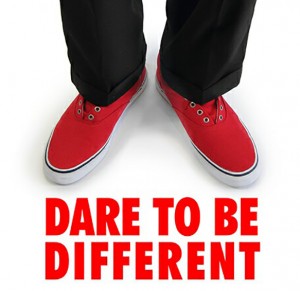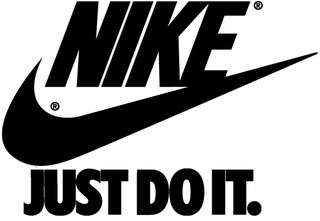 There’s a traditional Japanese proverb that says “The nail that stands out is quickly hammered down.” For generations, conformity has been a societal standard in Japan.
There’s a traditional Japanese proverb that says “The nail that stands out is quickly hammered down.” For generations, conformity has been a societal standard in Japan.
The funny thing is, it’s not that different in American business. More companies, large and small, are comfortable looking like all the others and doing things the way they’ve always been done. Breaking away from tradition is something one dare not do for risk of offending someone, or making the folks in the back offices uncomfortable.
To that, I say, Poppycock, balderdash, bull-pucky!
Every once in a great while, I’ll see some marketing effort that is truly exceptional, even edgy – and I’ll contact the marketer and ask about the results. Almost all tell me that the effort was successful and helped them stand out in their marketplace.
Do they get complaints? Yes, some…but mostly they get new business, so it’s worth the risk. And this has also been our experience. When an advertiser Dares to be Different, they get noticed, and sales commonly start to follow. Which is why our own motto, Dare to be Different, has been on our lips since we began in the 1990s.
And the funny thing is, it doesn’t take much to be different and get noticed.
Take our Red Shoes, which we always wear to conventions. You might say it’s our walking trademark, but really, it’s just our putting our own philosophy where our feet are.
People we’ve never met, never spoken with, stop us as we walk down the aisles wanting to know about our red shoes. When we walk along the booths, we’re always noticing how people’s eyes suddenly dart downward to our shoes and they smile. Friends will see us all the way across the hall because our red shoes stand out, even in a crowd. We even had one guy tell us, “I’ve now seen you walking down this aisle four times – but I never noticed anyone else!”
All this from just wearing a pair of red shoes. What does that tell you?
Different is visible. Different is memorable. Different is interesting.
So, the question is… will you Dare to be Different to capture attention and get new business? Or is your own comfort zone holding you back? As I always like to say, if you don’t know the answer to this, your audience certainly does.
####
Dan Katz is president, creative director of LA ads. To discuss your thoughts with Dan on this blog or any marketing matters, email via this link, or visit www.LAadsMarketing.com. You can also connect with Dan on LinkedIn. See agency work via this link.
 “Life can only be understood backwards; but it must be lived forwards.” – Soren Kierkegaard
“Life can only be understood backwards; but it must be lived forwards.” – Soren KierkegaardThe last quarter of 2016 is almost history and as we stand poised to welcome 2017 in less than 2 weeks, we hope for a future that is successful, rewarding and where your dreams will be realized. Having seen the start of more than a few “new business years” during my career, I’ve learned that you can do one of two things in preparation for the coming year. You can yet again try to create a brand new marketing strategy for the coming year or you can pause, look back and do some serious reflecting, resolving to change, or improve some aspect about how you will initiate your future marketing campaigns. For some people, looking back over the past year may be something better left in the rearview mirror; on the other hand, burying your head in the sand can be seen as the primary ingredient in a recipe for another disappointing year…and you know how much the CEO/President/Owner/Founder loves that kind of thinking. So, before one celebrates the dawn of a new year…take time to ask yourself what are you going to do to change? What does success in 2017 look like to you and your executive management team?
Speaking for myself and our firm, the end of each year is met with a healthy dose of optimism for the coming year. We see 2017 through a lens of hopefulness, that things will continue to get better. Is that just us or will you and your organization also view the coming year with a level of anticipation that you haven’t had for a few years? Hey, it’s been tough for most everyone out there but let’s remember that at least a few organizations — perhaps some of your own competitors — have fared better than most despite these trying times. So what have they done to plot a course for a more optimistic and profitable path for success in 2017?
Depending on marketplace factors coupled with how well you were able to strategically position and market your company, the past year was either seen as a success or another year of same-old, or even a disappointment. The question that begs to be asked here is, how much of last year’s growth or lack thereof was because of something you had no control over, such as good or bad luck, and how much was because of something you specifically chose to do or not do? I’ve found through personal experience this is the time to be totally honest with yourself. As Sigmund Freud said, “Being entirely honest with oneself is a good exercise.”
Hey, I’m all for a bit of luck but you probably don’t want to continue betting future success on lucky things happening in the coming year. With this in mind, here are a few questions to ask yourself as thought starters as you begin the process of looking in the rearview mirror at this past year and through your windshield to the next:
As marketers, one thing we know for sure is that change will not stop in 2017. The marketplace will continue to shift on us, and so will the economy. But by reflecting back on 2016, taking control of your marketing activities rather than being tossed around by the waves in the market, along with thinking optimistically about what 2017 can hold, this New Year might actually be a year worth celebrating. It will be for us and hopefully will be for you as well.
####
Rolf Gutknecht is vice president, director of account services for LA ads. To discuss your thoughts with Rolf on this blog or any marketing matters, email via this link, or visit www.LAadsMarketing.com. You can also connect with Rolf on LinkedIn.
 Just the other day my daughter told me that Facebook let her know that 6 years ago we brought home our German and Australian Shepherd mix whom we named Sadie. While I wasn’t sure we needed another dog at the time, I’m sure glad we decided to do so as Sadie’s been a wonderful dog. I mean, wonderful! So, where’s all this going? Stay with me.
Just the other day my daughter told me that Facebook let her know that 6 years ago we brought home our German and Australian Shepherd mix whom we named Sadie. While I wasn’t sure we needed another dog at the time, I’m sure glad we decided to do so as Sadie’s been a wonderful dog. I mean, wonderful! So, where’s all this going? Stay with me.
In the beginning, we were called by a dog rescue association we had connected with. They said they were getting a few dogs within a couple of days and, based on our interest in the Australian Shepherd breed, we might be very interested. So on that day we went, and while we were playing with the dogs, it became clear that this little one was an “A-personality” pup, full of energy and a little headstrong. When I told my family that she was the one I wanted, they asked why. I told them that I wanted a dog that was going to give me a bit of a run for my money and based on what I saw of her, my thinking was that she’d be the smartest, healthiest and probably the most rascally of the bunch. In this case, I was right and I’m glad I went with Sadie versus some of the other dogs who were more on the passive “follow you all around the house” side. With all that as the backdrop, there’s a lesson here about developing effective, sales-producing marketing campaigns. I told you we were going to get there.
So with all that in mind, let’s go back to my experience in picking Sadie:
When you design your business and marketing strategy, will you go with the easy way – following what others are doing – picking the dog most others would – or do you challenge yourself to go beyond the accepted norms, to think for yourself, to dare to be different, to self-define the limits of what is possible? History has shown the most successful companies have chosen the puppy who doesn’t act like the others.
####
Rolf Gutknecht is vice president, director of account services for LA ads. To discuss your thoughts with Rolf on this blog or any marketing matters, email via this link, or visit www.LAadsMarketing.com. You can also connect with Rolf on LinkedIn.
First, a cork-popping congratulations to the Broncos, and condolences to all the Panthers fans. Now comes the Monday-morning quarterbacking and all the after-game analyses, almost as much fun as following this year’s election season!
But personally, I think the big winner in the game was Kia Motors, whose “Walken Closet” commercial was one of the truly great moments in Super Bowl advertising. Feel free to click here to watch the spot and then come right back for the play-by-play.
Welcome back!
For a commercial – or any advertising, for that matter – to be effective, it has to accomplish several critical feats: It has to break through and attract attention, it has to be clear in its fundamental selling message, the message has to be compelling, and it has to be memorable when you walk away from it.
I’ve argued for years that most Super Bowl commercials only accomplish the first and last requirements. You watch and enjoy them, you may laugh at their gags and you talk about them after the game. But on the selling-side, most hardly make it past the scrimmage line. They don’t leave you wanting to know more about the product or even “get” the product’s unique selling proposition (USP), the thing that makes the product unique among its competitors. That surely can’t be said of the Kia spot.
First off, who can’t be drawn into Christopher Walken’s creepily intense performance no matter what he does? And the gag about the “Walken closet” is hilarious. But when Walken metaphorically compares most mid-sized sedans to uninspired beige socks and the Optima to the “world’s most exciting pair of socks,” in a way only he can deliver, he absolutely nails the Optima’s unique selling proposition: a car with “pizzazzzzz” in a world of otherwise boring mid-sized competitors. If you’re thinking about buying a mid-size after watching this commercial, you’re compelled to at least check out the Optima. (After all, who wants to be boring and beige?)
Our lives are way too busy for us to be attracted to “beige” things. Yet, too many marketers don’t project that same line of thinking toward attracting customers. Decisions are made daily to keep producing and running the same run-of-the-mill, uninspiring stuff…week after week, year after year.
Keep in mind that when you as a consumer see anything from a company, either your opinion of that company is enhanced or it’s not. There’s no middle ground. You either like them a bit more or you go in the other direction. So why do so many marketers turn that compelling, money-making value proposition into a beige and uninteresting “me-too” message that each and every one of their competitors could say.
I don’t know about you, but I’ve never been bored into buying anything. And I’m even going to say that 99% of your customers are with me on this. The marketing you do for your company should be an extension of you. You’re the person who’s responsible for communicating the passion of your company. When you talk about your business with others, hopefully your eyes twinkle, your heart begins to race, your voice becomes more dynamic and people are instantly attracted to you. When that show of enthusiasm and excitement happens, no one would confuse you with being boring, right? Of course not. So look at your marketing and see if it reflects that same level of specialness. (Or you could always ask friends, colleagues or suppliers who will be candid with you, “Does this marketing make you want to pick up the phone or know more about us?” If the answer is not an enthusiastic “yes,” then it’s time to start over.)
In a world of “beige” mid-size sedans, there’s the Kia Optima. In your competitive world where there’s so much beigeness, where do you stand? C’mon, punch it!
####
Rolf Gutknecht is vice president, director of account services for LA ads. To discuss your thoughts with Rolf on this blog or any marketing matters, email via this link, or visit www.LAadsMarketing.com. You can also connect with Rolf on LinkedIn.
 I think we would all agree that having hope in one’s life, personal or business, matters a lot. Without hope (or dreams) whatever the positive outcome is that you’re looking to achieve, there is nothing to plan or look forward to and therefore no reason to put forth an effort. So while hope is important, basing the success of your marketing efforts on hope, like in “Well, we’re going to try this out and hope for the best,” is probably not something you want to bet your job or the sustainability of the company on.
I think we would all agree that having hope in one’s life, personal or business, matters a lot. Without hope (or dreams) whatever the positive outcome is that you’re looking to achieve, there is nothing to plan or look forward to and therefore no reason to put forth an effort. So while hope is important, basing the success of your marketing efforts on hope, like in “Well, we’re going to try this out and hope for the best,” is probably not something you want to bet your job or the sustainability of the company on.
You see, while hope may fill your heart… in marketing, Hope is not a Strategy. It never has been and it won’t be in this growing and increasingly competitive marketplace. Hoping people will register for a loyalty program or hoping the 5000 direct mail pieces you sent out will generate some leads or hoping that word-of-mouth on the new product introduction will open up some doors is all nice but without strategic thinking coupled with creativity (in the delivery of the message and how it’s delivered) your hope is nothing but a pipe-dream. In short, if there is no marketing strategy to match the business goals all you are doing is relying on luck to drive the business. In football, they call this the “Hail Mary”!
Speaking with the number of Marketing Directors that I have, you’d be surprised at how many of them and their teams use the word ”hope” to describe their marketing efforts. The reasons most of these folks live on hope has as much to do with human nature as anything else. Most people prefer the path of least resistance – the easiest track. You see, having a grasp of what your current customers and prospects are looking for and how you fit that need requires an understanding that takes work and resources. Oh, and let’s not forget that if you look too close, you might uncover some truths that you might not want to know existed. And rarely does one budget time or money for testing to learn what will have the best chance of success. For the “hope group,” it seems it’s easier to just create the marketing program and run with it rather than invest the resources and thinking to at least have some confidence in the outcome.
Here are a few things that “Hope Marketing” does and doesn’t do…
…Built around tactics and not strategy:
Hope Marketing people focus on the newest and sexiest marketing tactic du jour without any appreciation for how it fits in an overall marketing strategy. I’ve also seen entire marketing plans that consist of nothing but a series of tactics strung together one after the next without an over-arching marketing strategy. It’s easy to start with the “how” but if you haven’t identified the “what,” you may find yourself spending a lot of time executing tactics that don’t take you where you want to go and in so doing, you’ll be wasting time, resources and losing out on sales-producing opportunities.
…Based on an “insight-out” view of the world and not an “outside-in”:
Inside-Out thinking means the company is less sensitive to how the customer is interfacing with the market. Hope Marketing has slipped into thinking it’s “all about us and what we sell.” Inside-Out companies are surprised by poor sales results. They don’t feel threatened when a new competitor enters the market. They’re out of touch with what value they really bring – or don’t bring – to their customers. In short, their Hope Marketing mindset is “Here are our products and services and this is how we help you.” The problem with this approach is that it relies on your customers having to work to find a place for your solutions in their lives. Alternatively, “Outside-In” focuses on the customers’ point-of-view. These companies stand in the customer’s shoes and view everything the company does through the customer’s eyes. They depend on marketing to increase the conversation they have with their customers which in turn allows them to seize on business-building opportunities. They ask their customers what their upcoming needs are and then figure out how to give it to them. These companies don’t wait around for change to happen but rather they create change by seeing their world through their customers’ eyes, allowing them to more quickly meet the customers’ needs.
…Not really understanding who your customer is:
It’s safe to say that it’s probably been a while since a Hope Marketer has actually taken a close look at who they should be reaching/their customer, to produce sales. When was the last time a customer profile was established? What are the best channels nowadays to reach these people? When was the last time the company spent real, quality time doing research – surveys, interviews or even focus groups.
…Not clearly knowing what customers or prospects think of you:
On the subject of research, there’s no excuse for not doing it. Yes, I know that budgets are tight, but if you’re spending money reaching an audience that may not think of you as they did in the past, then the money spent Hope Marketing is money wasted. Hope Marketing believes that nothing much has changed and if it has, it’s not affecting the company’s sales/preference/etc. Maybe…and maybe not. Doing research online or on social media to see what customers or people are saying about you doesn’t take soooo much effort. Sending out a survey to current customers on a variety of different subjects isn’t an overwhelming project. You might not love what you hear but you’ll be better knowing it than guessing why marketing activities are not succeeding.
…Not understanding what makes your company and what it offers unique:
It’s not unusual to hear in organizations that engage in Hope Marketing differing answers to questions about what defines them or makes them unique in the marketplace. As a result, the marketing reflects that they’re trying to be all things to all people. At closer look you see that messaging is different from one marketing channel and marketing initiative to the next. “We do it all” is more or less the message but in doing so, no real value proposition is ever delivered. Without a good USP you’re dead! If you can’t very quickly describe what makes you, your product, your service or your company truly special in the eyes of the customer, don’t expect your customer to do it for you. By default, they’ll just put you on the shelf called “commodity,” and there you’ll stay.
So, if you still want to hope for things to look forward to…great. I’m all with you. Hope for a better tomorrow; hope for a cure to Alzheimers; or hope for anything else that you can’t directly control. But please don’t hope your marketing programs work. If you don’t know or believe the marketing will succeed, you are not setting your efforts up for success. Time to stop crossing your fingers.
####
Rolf Gutknecht is vice president, director of account services for LA ads. To discuss your thoughts with Rolf on this blog or any marketing matters, email via this link, or visit www.LAadsMarketing.com. You can also connect with Rolf on LinkedIn.
 It’s one of the more iconic moments in film over the last three decades. Robert De Niro plays taxi driver Travis Bickle, who in one chilling scene looks at himself in the mirror, a pistol up his sleeve, and says to an imaginary adversary, “Are you talkin’ to me? You talkin’ to me?”
It’s one of the more iconic moments in film over the last three decades. Robert De Niro plays taxi driver Travis Bickle, who in one chilling scene looks at himself in the mirror, a pistol up his sleeve, and says to an imaginary adversary, “Are you talkin’ to me? You talkin’ to me?”
What’s this have to do with marketing? Well, as consumers we’re actually all asking this question whether we think about it or not. Because the only marketing that breaks through the clutter is that in which the message undeniably speaks directly to the reader/viewer/listener/user from his or her own perspective. The reader/viewer/listener/user knows for certain, “You’re talkin’ to me!”
Here’s what I mean:
Recently, we saw an ad for mortgage company with a photo of a man dressed in a business suit leaning backwards like an acrobat. The headline said “Can your mortgage broker do this?” On the surface, you might say that’s a humorous, attention-getting ad. But really, it’s just showing a visual pun without telling any compelling story about what flexibility means to the reader. It’s just saying so and nothing more. Compare that to another mortgage company’s ad that showed one of those toy labyrinths where the steel ball might drop through one of a dozen holes in the maze at any turn, and the headline says “We know just how you feel about refinancing your house.” The first ad speaks from the company’s point of view, the second speaks from the reader’s. There’s no question that in the second ad, the reader knows “You’re talkin’ to me!”
If you want your audience to connect with your message, it has to be based on their real experiences and what’s in it for them, instead of all the features you have to offer.
It’s ridiculous that I have to say this but the memo has not reached the desk of many marketers, so here goes: “It’s not about what your company wants to say but rather about what the customer wants to hear.” (I feel better having said it.) Look, if you want to market based on your personal preferences without regard for what works best with your prospects, that’s your prerogative. But I’d suggest that your company’s marketing not be so self-absorbed. Remember, you don’t buy from you, others buy from you and they don’t care about your business and your troubles nearly as much as you do. Most people are tuned into Radio Station W.I.I.F.M. —“What’s In It For Me!” If your marketing message is all about you, then your customers won’t notice what you’re saying. Please begin to “tune” into your customers, find out what they really want and focus your message on them.
We recently conducted a webinar about exhibiting at a major trade show that one of our client’s exhibits at. It’s tragic how many booths fail to attract traffic simply because they don’t design their exhibits from the audience’s perspective. They’re loaded with too much feature-based content and lack a simple benefits-oriented message. No one passing by would stop and say “You’re talking to me!”
A shift in perspective from speaking about yourself to speaking from the audience’s point of view can be remarkably effective. Witness a beautiful commercial for a British online content company featuring a blind man whose original cardboard sign talks about himself,
“I’m blind. Please help.” But when a caring passer-by changes the words to be more audience-focused, something powerful happens. [youtube https://www.youtube.com/watch?v=Bq3Dgy3Wx_0&w=560&h=315] As marketers, the symbolism of what you or your firm can offer the organization, is front and center.
No matter what you sell, manufacture or service, it’s critical that you change your marketing message’s perspective from talking at your audience to talking to them, causing them subconsciously to acknowledge, yes, “You’re talkin’ to me!”
####
Rolf Gutknecht is vice president, director of account services for LA ads. To discuss your thoughts with Rolf on this blog or any marketing matters, email via this link, or visit www.LAadsMarketing.com. You can also connect with Rolf on LinkedIn.
 Oh, the wonder of beautifully crafted taglines. Those few strategically selected words that sum up everything your business stands for and what you want your target audience to know about you. They’ve made companies fortunes by telling people what makes them stand out in the sea of sameness. Consider FedEx’s brilliant “When it absolutely, positively has to be there overnight.” Nine simple words that tell FedEx buyers precisely what they’re going to get, while simultaneously informing all of its employees what their mission is. What if FedEx’s slogan was “We ship things!”? Would Nike be as successful if it allowed an executive committee to red-pencil “Just do it” into “When you need great shoes?” How would BMW’s vision change if “The Ultimate Driving Machine” became “Our cars are fun to drive!” My point is that these companies didn’t settle for weak platitudes or vague, generalized statements that could have applied to their competitors. Nope, they decided that they weren’t going to settle. Instead standing out and differentiating themselves was business-critical. Can the same be said for your company and its marketing? Do you have a themeline or slogan that makes you stand out? Is it unique and memorable? Or is it mediocre because somewhere down the line, people settled?
Oh, the wonder of beautifully crafted taglines. Those few strategically selected words that sum up everything your business stands for and what you want your target audience to know about you. They’ve made companies fortunes by telling people what makes them stand out in the sea of sameness. Consider FedEx’s brilliant “When it absolutely, positively has to be there overnight.” Nine simple words that tell FedEx buyers precisely what they’re going to get, while simultaneously informing all of its employees what their mission is. What if FedEx’s slogan was “We ship things!”? Would Nike be as successful if it allowed an executive committee to red-pencil “Just do it” into “When you need great shoes?” How would BMW’s vision change if “The Ultimate Driving Machine” became “Our cars are fun to drive!” My point is that these companies didn’t settle for weak platitudes or vague, generalized statements that could have applied to their competitors. Nope, they decided that they weren’t going to settle. Instead standing out and differentiating themselves was business-critical. Can the same be said for your company and its marketing? Do you have a themeline or slogan that makes you stand out? Is it unique and memorable? Or is it mediocre because somewhere down the line, people settled?
Imagine you owned a small piece of your buyers’ brains. And every time they thought about making a purchase where your product or service could be considered as an option, the brand or company name came to mind. For example if they were thirsty, they thought, “This Buds for you, “ or if they wanted a burger they thought, “Have it your way!” or if they when were tired and looking for a lodging for the night they remembered “We’ll leave the light on for ya!” That’s what the marketing slogans from Budweiser, Burger King and Motel 6 do, they help people remember a product and increase their propensity to buy. And that’s what a good marketing slogan can do for you. Unlike your company tagline or marketing message, your marketing slogan may change regularly or you may have more than one. For example American Express has: “Membership has its privileges.” And “ Don’t leave home without it.”
The taglines that work the hardest are not puns or rhymes, but ones that present many layers of meaning, where one layer can speak to the product while another speaks to value or even a brand a brand belief. It can manifest itself in any number of ways…online or offline. In ads and as a social media hashtag. On promotional products and product packaging. Most everywhere.
So what does a good tagline do? At its best, a good tagline conveys a singular value, loud and clear, on what a brand stands for. Remember, powerful words are powerful things. It also connects across all generations, geographies and markets, and becomes relevant for the consumer in his or her own personal way. And the right tagline doesn’t work for competitors because it’s only unique to your brand/company. Unfortunately, far, far, far too many taglines are generic and meaningless. In this time of technology disruption and increasing competition, clear positioning is valuable. Problems occur when the company and its messaging doesn’t have a focus, or the tagline could apply just as easily to other companies. In the marketplace, taglines are used to quickly communicate company differentiation. That said, taglines aren’t developed for customers alone. They’re also important for internal audiences as they can align an organization around a common cause and vision.
With that in mind, there are plenty of taglines out there that don’t work because they fail to connect. They’re easily overlooked, dismissed as “every day,” they lack originality or even mistaken for another brand. This usually happens when one of these mistakes happens:
Alternatively, good taglines have a number of hard-working qualities to them. They’re:
The process of developing a fresh, original and imaginative tagline is no easy task. From competitive research and brainstorming to paring down the list of options to more brainstorming, the process can take more time than you think …not to mention the back-and-forth given the stakeholders who are involved. And even then, the tagline may not be “all that.” That said, here’s how powerful a tagline can be – after 50+ years! Avis Rent-A-Car built its business with “We Try Harder” (which they finally put out to pasture just a few years ago). How the phrase came to be sounds like something out of Mad Men. The tagline was created in 1962 and actually came about in the response that Bill Bernbach, the co-founder of DDB, received from company management when asking why anyone ever rents a car from them. “We try harder” was the answer. Within a year, Avis turned a profit for the first time in over a decade and the rest is history.
####
Rolf Gutknecht is vice president, director of account services for LA ads. To discuss your thoughts with Rolf on this blog or any marketing matters, email via this link, or visit www.LAadsMarketing.com. You can also connect with Rolf on LinkedIn.
 A couple of weeks ago, I was at a trade show and after walking up and down the aisles, it occurred to me just how much of the same-old, same-old I was seeing. Nothing really new (unless you consider irrelevant modifications like changing the color from blue to orange and different shaped bottles as new). There was nothing that I can say showed me that companies were spending any amount of time and energy in looking at the marketplace with an eye toward identifying the opportunities that trends in customer purchasing or behavior would present.
A couple of weeks ago, I was at a trade show and after walking up and down the aisles, it occurred to me just how much of the same-old, same-old I was seeing. Nothing really new (unless you consider irrelevant modifications like changing the color from blue to orange and different shaped bottles as new). There was nothing that I can say showed me that companies were spending any amount of time and energy in looking at the marketplace with an eye toward identifying the opportunities that trends in customer purchasing or behavior would present.
With that as that backdrop, on my flight home I started thinking about the ways that the marketing department within an organization can start the process of getting out in front of their competitors in order to seize on untapped business opportunities and identify trends before their competitors do. It’s really not as difficult as a lot of people think, but it does require that one to think more about the future by asking questions around the idea of “so what does that mean?” As an example of this, watch the video clip that stars Kevin Spacey for E*Trade.
In short, imagine if you could get a 12-18 month head-start on everyone else in your industry. Wouldn’t even 6 months be nice? Wouldn’t that make a huge difference in how your business runs? Maybe you could get the jump on your competitors every single time you make a move. Heck, this would even apply not only to products and services but also to channels, processes and even personnel hires.
Before we get into the ways that one might start spotting new trends, it’s important to understand a few things. So here goes:
OK, with that as the backdrop to trend watching, let’s walk through the process of how and where to find possible trends:
Now that you’ve identified some trends, where do you go from there? First, think about the consequences if a trend continues to spread. How will the trend change what people buy? What will happen if the trend grows in strength? Here’s where you have to ask yourself a lot of questions about “what does that mean?” In short, imagine the future (and your future) if the trend plays out. After you have in your head what the trend might look like, identify what need is currently being unmet that, if created, will help customers take advantage of the future scenario. And then lastly, define what the product or service opportunity is— that being the space between what is currently available and what people who would be effected by the future trends will want.
Here’s the choice you have: As a company, you can sit around and talk about strategies year after year. You can even hire consultancy firms to tell you what’s hot…last year. You can scratch your heads at all that new stuff that you’re seeing but end up sticking to known quantity. Or, you could wrap your mind around the potential that a new product or service has to offer. You create your own crystal ball!
Maybe the people who are good in spotting trends and anticipating what people want are able to imagine what others can’t. These trend spotters collect relevant data from what they read and hear and can read between the lines. Hopefully you’re one of those people.
Just remember, the sooner you spot an opportunity, the more time you have to leverage the tar out of it. And the faster you can move on an opportunity, the more likely it is that you will score a win. Keep your eyes open.
####
Rolf Gutknecht is vice president, director of account services for LA ads. To discuss your thoughts with Rolf on this blog or any marketing matters, email via this link, or visit www.LAadsMarketing.com. You can also connect with Rolf on LinkedIn.
 I think we can pretty much all agree that most everyone, be it on the job or in our personal lives, is stretched thin on time. And this crunch for time has shortened our attention spans and concentration levels to the point that we’re lucky if we even remember some bits and pieces of phone conversations, face-to-face discussions, emails, etc., let alone those marketing messages that other companies put out in the marketplace in hopes we’ll act on them. Who has time for them?
I think we can pretty much all agree that most everyone, be it on the job or in our personal lives, is stretched thin on time. And this crunch for time has shortened our attention spans and concentration levels to the point that we’re lucky if we even remember some bits and pieces of phone conversations, face-to-face discussions, emails, etc., let alone those marketing messages that other companies put out in the marketplace in hopes we’ll act on them. Who has time for them?
With that scenario playing itself out in most everyone’s lives, marketers have a hard nut to crack when it comes to creating marketing messaging that sticks in order to counterbalance people’s shrinking attention span. Every marketer faces this reality daily. As most of us have heard, the average attention span does not exceed eight seconds (ten years ago it was 12 seconds). Comparatively, the attention span of the average goldfish is nine seconds. Capturing attention within eight seconds is a formidable challenge. As marketers, we have enough trouble with summarizing a message into a small packaging label, a web banner, a half page magazine ad, an outdoor board, or other media channels where the time or space allows for only something along the lines of a “quick bite.” Remember when the 60-second TV commercial was the norm? Then it went to 30 seconds and now we’re seeing more and more 15’s. And Vine built a platform around 6-second video posts and YouTube incorporated a “skip ad” option on their commercial videos after five seconds. Any more than that, and viewers lose interest and get really ticked off .
Oh, and let’s not forget about how the shrinking attention span has also led to people fidgeting between multiple screens (their TVs, computers, smartphones and tablets) at a rate of up to 21 times per hour, according to a recent study. Guess the average minutes a day that a person spends on their smartphone? 147 minutes. Now compare that to just under 120 minutes per day watching TV. Boy, we are distracted!
Growing evidence blames Internet, TV and computer games for creating shorter attention spans. Bombarded daily with mind-boggling amounts of things to read, watch and respond to, most of us have real difficulty paying attention on one subject for longer than a couple of seconds. How to fight against this rapidly decreasing attention span of an average consumer? How do you market to a group of people who don’t have enough time to listen to everything you have to say? It’s hard, and it’s getting harder to get and keep anyone’s attention.
Well, some marketers are trying to get people’s attention by going where more people seem to be…on social media, the “Land Of A Million Tweets, Comments And Posts” that repopulates itself every few days, or hours…or even minutes. And then there’s special offers, sales, email blasts and just about anything else that has a slight chance of possibly working. In doing so, I’d argue that for many companies, they’re not breaking through the clutter but instead adding to it.
It’s more important than ever to hold the attention of customers and prospects quickly and interactively in ways that weren’t possible or necessary in years past. So here are 5 messaging tips that will go a long way to having your audience stay tuned rather than drift away:
Now, at a time when attention spans are shorter and less focused than ever, you need to be more focused on making sure your marketing messaging doesn’t fall on deaf ears. There is too much noise because too many people want to be noticed without having to say anything worth hearing. The genuine voice sounds different and therefore it can be more easily discerned. The problem is, because of so much noise, people are hardly listening any more – expecting to hear nothing of worth anyway. Make every effort to be the voice that gets heard.
####
Rolf Gutknecht is vice president, director of account services for LA ads. To discuss your thoughts with Rolf on this blog or any marketing matters, email via this link, or visit www.LAadsMarketing.com. You can also connect with Rolf on LinkedIn.
 As a marketing firm that’s always looking to engage in new business relationships with interesting companies, we continue to have more than our share of new business meetings. These companies run the gamut from small to “you’ve heard of this company before” and while they’re sometimes far removed from one another in terms of sales and recognition, a surprising number of times there’s not that much of a difference in their approach to their marketing initiatives which, as my business partner puts it, “borders on marketing malpractice.”
As a marketing firm that’s always looking to engage in new business relationships with interesting companies, we continue to have more than our share of new business meetings. These companies run the gamut from small to “you’ve heard of this company before” and while they’re sometimes far removed from one another in terms of sales and recognition, a surprising number of times there’s not that much of a difference in their approach to their marketing initiatives which, as my business partner puts it, “borders on marketing malpractice.”
How am I defining “marketing malpractice?” Well, while it might take form in a few different ways, it’s primarily about a breach of duty that does harm when another course of action, as performed by a reasonable person, should have been taken. In short, it’s about negligence. While malpractice is commonly associated with the medical, financial and legal world, it could also be readily applied to the marketing world as well.
With that in mind, let’s look at 5 ways that companies and marketing leaders could become guilty of marketing malpractice:
Not having a full grasp of the marketplace
Too many companies assume that there is absolutely no need to substantiate their beliefs about the marketplace, about what their prospects want, about why their customers are buying, about what people think of their brand, about most anything having to do with those whom they want to purchase their products or services. Generally the thinking is that no one can know the marketplace as well as the company and the market will accept whatever you offer. Are you pretty darn confident on how your specific industry is changing and what is needed to get out in front of the competition? Understanding the marketplace as a whole will create the opportunities that bring with it the sales, visibility, prominence, trust, etc., that you might be looking for. And you get there by doing some research…the right way.
A lack of focus
The “We have to be here, there and everywhere” thinking is a sure way to squander the limited budget that you have. And who said that you need to be all over social media platforms like LinkedIn, YouTube, Facebook, Twitter, Google+, and Pinterest? Heck, you’ve got your product literature online, and your Web site has a blog and videos. Not to mention all the offline activities ranging from tradeshow activities to advertising to PR, etc. Why did you believe you need to be in ALL of these media locations in the first place, and, just as importantly, who is making sure that all of these activities work together?
Inconsistency or mixing of marketing messaging
When different aspects of your marketing messages don’t reinforce each other, the inconsistencies alienate prospects and current customers. Inconsistent marketing distorts clear expectations, makes potential customers unsure of the characteristics of your products and creates unhappy customers who don’t get what they expect. These inconsistencies affect businesses by reducing both initial sales to consumers as well as repeat sales from dissatisfied customers. Throwing stuff up against the wall to see what sticks is a clear path to wasting resources and confusing people/organizations that you want as customers.
Being just like the other guy
How many times have you read or seen something from one company that looked just like what one of their competitors has or is currently saying? For an example, go online and look at professional services firms and tell me why one is different from the other. The fact is that there is no relevancy to what you’re saying if you just keep repeating what others have said already. Your company/products/services only has value if you’re different and if you can find a way that you can take who you are, what you make, and what you offer and create a relationship with prospects and current customers that is instantly captivating. Striving for differentiation rather than being a “me-too” allows for the organization to seize on new sales-producing and revenue-generating opportunities. Otherwise, you’re just a lazy copycat…two words that don’t leave the minds of the customers and competitors anytime soon.
Confusing strategy with tactics
Maybe, just maybe, the most common marketing malpractice occurrence is not having one over-arching marketing strategy – and ensuring its implementation through all your tactics. Executing marketing tactics without having a well-developed integrated strategy is a recipe for disaster. It’s easy to start with the “how” but if you haven’t identified the “what,” you may find yourself spending a lot of time executing tactics that don’t take you where you want to go and in so doing, you’ll be wasting time, resources and losing out on sales-producing opportunities. What is needed is one single integrated strategy that looks across all delivery platforms whether online or offline, print, broadcast, or mobile. Your customers don’t have an online self and offline self and neither should you. Think holistically about all your marketing initiatives.
At the end of the day, both the short-term and quite possibly the long-term prospects of the company could be affected as a result of marketing malpractice. Whether done because one doesn’t know better or because of expediency, it happens and the organization will have to live with the results. So, while you won’t be brought into court (unless you did something very egregious), one question that a marketer has to ask oneself and answer honestly, is: “Have I breached my duty as the marketing leader for the organization so much so that it has caused harm to both short and long term sales, visibility, prominence, market share, and trust for the company?” Hopefully, the answer today and in the future will remain a resounding NO.
####
Rolf Gutknecht is vice president, director of account services for LA ads. To discuss your thoughts with Rolf on this blog or any marketing matters, email via this link, or visit www.LAadsMarketing.com. You can also connect with Rolf on LinkedIn.